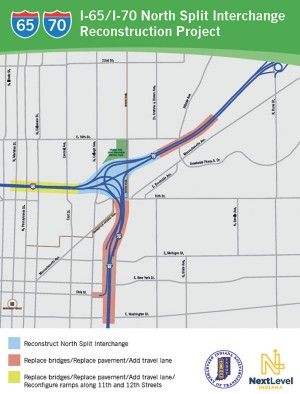The Indiana Department of Transportation (INDOT) announced in September 2017 their intention to reconstruct the I-65/I-70 split beginning in 2020. The scope of the project is huge, including the rehabilitation, replacement, and/or widening of 32 bridges, reconfiguration of the I-65 exit and entrance ramps on 11th and 12th streets, the addition of lanes on I-65 and I-70, and a reconstruction of the North Split interchange. The state noted that the interchange was 50 years ago, and can no longer handle the large amounts of traffic that flow through the interchange. About 170,000 vehicles travel through the interchange per day. Commuters are routinely stuck in traffic congestion in the “Spaghetti Bowl” and will attest to the need for significant improvements. The portion of the interstates included in the project are one mile of I-65/I-70 from the north split to Washington St., I-65 from Meridian to the split, and just west of the Keystone/Rural interchange to the split. Currently, INDOT has preliminary drawings and plans but nothing has been finalized.
However, some residents, especially in the historic neighborhoods and commercial areas that will be directly impacted, have started asking INDOT to consider alternatives to widening certain parts of the interstate which would put speeding cars even closer to their homes and businesses. In addition to encroaching into their neighborhoods with additional noise and pollution, INDOT has proposed replacing the current grassy berms with concrete retaining walls, using the berm space to build the lanes. Recently, the Indy Chamber and Mayor Joe Hogsett asked INDOT to consider alternatives to the plan, while not objecting to the ultimate goal of increasing traffic flow and safety through the heavily travelled area.
Lockerbie, Cottage Home, Chatham Arch, and the Old Northside neighborhoods will likely be directly impacted. The easternmost portion of the Mass Ave. corridor, and the Cole Noble neighborhood would also see changes. Before any construction begins, an environmental study will need to be done that will assess the changes in noise levels and their effect on neighborhoods and impacts to cultural districts and historic properties. The study will take about two years. Public open houses about the project have yet to be set, but are likely to begin in March.
To provide a larger perspective on the urban interstate’s role in creating (and destroying) neighborhoods and urban centers, Indiana Landmarks, which borders I-65 and would be impacted by widening the highway, will host a discussion with John Norquist, former Milwaukee mayor and author of The Wealth of Cities, who will discuss the impact of urban interstates and the quest for livable cities on February 26 from 6-7 p.m. at their headquarters, 1201 Central Ave. Admission is free. Doors open with a cash bar at 5:30 p.m., followed by Norquist’s talk and Q&A, 6-7 p.m.
After leaving elected office in 2004, Norquist spent a decade as president and CEO of the Congress for the New Urbanism, a national organization based in Chicago and Washington, DC, that promotes walkable, mixed-use neighborhood development, sustainable communities, and healthier living conditions. Based on his experience taking down the Park East Freeway, Norquist created a program at the Congress for the New Urbanism to help advocates and local officials pursuing alternatives to highway expansion. He has taught urban planning and development in universities throughout the country.



